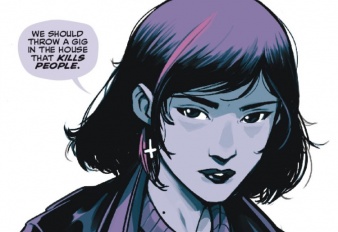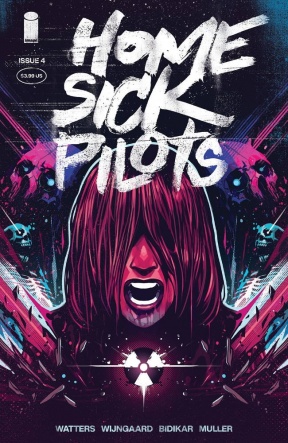Who’s This By?
“Home Sick Pilots” is written by Dan Watters, illustrated by Caspar Wijngaard, lettered by Aditya Bidikar, and designed by Tom Muller. You may know Watters from “Coffin Bound” and “Limbo,” both of which are also Image titles, or his work on “Lucifer” over at DC. Wijngaard also works on “Limbo” with Watters, as well as various Star Wars projects and “Peter Cannon: Thunderbolt,” among others. You can find Aditya Bidikar’s work on some other Don’t Miss This titles such as “These Savage Shores” and “Paradiso.”

What’s This All About?
It’s the 90s. The groovy, heady, vibes of the 70s and 80s West Coast have faded, replaced by the skaters and punk aesthetics of the grunge era. Kids are angsty, angry, and doing their best to heard. In come The Home Sick Pilots, this comic’s eponymous punk rock trio: Ami, Buzz, and Rip. They’re not here for a summer of love, and instead enter the scene for a summer of soul seeking, sticking it to the man, and crunching riffs. The plan: do the most punk thing possible, and play a house show at the haunted house nearby with a track record of killing its inhabitants. Their rivals The Nuclear Bastards will be there, and The Home Sick Pilots have a point to prove. That’s the vibe. This is a horror story, a coming of age story, and at times it’s almost a super hero story. Maybe the best way to think about “Home Sick Pilots” is as follows: this is the combination of the punk rock, comradery driven terror of the film The Green Room meets the shoegaze, teenage slow burn horror of It Follows, with just a dash of Teen Titans. For corollaries in comics, the aesthetics and story themes of “Home Sick Pilots” aligns with things like Locke & Key, Paper Girls, and Alienated.
What Makes It So Great?
If invoking the above comic and movie references wasn’t enough, we’ve got a few more buzzwords that get at what makes “Home Sick Pilots” so great: Demonic VHS monsters. Goth mecha ghost hunters. First love and heartbreak. Smart haunted house architecture that makes for some thrilling set pieces. And that’s before we get to the amazing art that just oozes cool.
To start, “Home Sick Pilots” has gotten such rave reviews in part because it’s just so quintessentially a comic. What we mean is that some stories work best in certain mediums. Some stories could only exist as movies, while others only reach their potential in the form of a novel. “Home Sick Pilots” is great because it knows how to make use of tools comics do better than anyone else. For example, Watters and Wijngaard make excellent use of simultaneous narration, flashbacks interposed with the present, art and text compositions that generate irony, and dynamic page constructions that amplify the themes of the story. Take, for example, panel shifting pages that generate a feel of claustrophobia and futility, which are perfect for a haunted house story and which wouldn’t hit nearly as hard outside of the comics medium. For another example, there’s Ami’s witty, punchy internal monologue that flitters above the page, creating a sense of playful yet dreadfully dark humor. She’s a great character with a unique personality that really comes through when matched with the art on the page. We don’t think her persona would come across nearly as strongly outside of the comics format.

We’ve touched on it a little bit, but what makes “Home Sick Pilots” so good specifically is its focus on smart characterization. Watters infuses “Home Sick Pilots” with a coming of age precocious that comes across most in our protagonist Ami’s character. She makes good observations about how being haunted (and in the case of this, specifically possessed by a house) and playing basement shows have the same energy: exhilaration, and a high of control, followed by a realization that maybe this isn’t all you thought it was going to be. Watters has discussed his own history in the punk scene, and as such the insights into subculture and belonging in “Home Sick Pilots” are smart and well informed. Additionally, Ami’s relationship to the Old James House (that’s the one that’s haunting her) is interesting, and can be read as a metaphor for a variety of unsavory relationships. Ami finds herself in a lot of difficult situations. She helps the house, so shouldn’t the house help her back? And if not, why? Because the house is evil — maybe. Or is it because the house knows something she doesn’t, and is really trying to protect her. The reader runs through these thought trees in real time, and we feel right their with our protagonist. In terms of haunted house stories with a unique premise and stellar writing, “Home Sick Pilots” ranks high.
Continued below
The phrase “location as character” is a bit overplayed, but in “Home Sick Pilots” the concept is taken to the next level — not just by Watters, who makes the house a character itself, with dialogue and all, but through Wijngaard’s illustrations. He does a great job merging the Pacific majesty of an idealized California coast with the mayhem grind of horror and punk. The result is a story suffused with reds, pinks, and blues that read equal parts neon nightlife and Hollywood excess as they do blood soaked walls and lonely, inky skies. The juxtaposition of colors never feels yucky, and really ups the general angst of the story. As “Home Sick Pilots” has continued the architecture of the house has also expanded, and Wijngaard does a great job showcasing all the horrid nooks and crannies of the place. His style is realistic, which makes each scene very legible. There’s a lot going on in these pages, but Wijngaard always ensures that the reader knows who the center of the action is, drawing our eyes to the right place every time.

“Home Sick Pilots” really should be on your pull list — there’s just so much to enjoy here from a narrative and aesthetic point of view. The well defined West Coast color palette mixed with a novel take on the haunted house trope, plus memorable characters makes for a worthy tale. Check out “Home Sick Pilots” the next chance you get.
How Can You Read It?
The first three issues of “Home Sick Pilots” are already out, and can be found via your local comic shop or online at comiXology. Issue four is due this week on March 10, with the next issue arriving April 14th.






